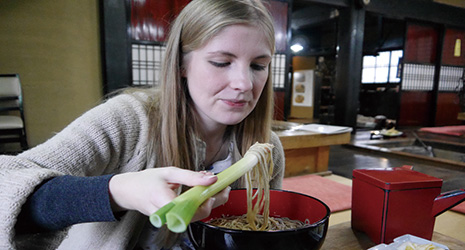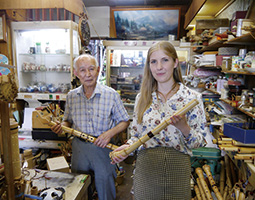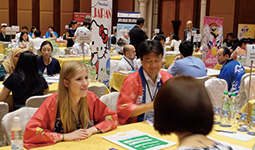Home > Highlighting JAPAN > Highlighting Japan March 2018 > My Way
Highlighting JAPAN


Sharing the Allure of Fukushima
Zoë Vincent, from the UK, has been blogging about great places to visit in Fukushima Prefecture, as well as documenting the progress of the revitalization of the prefecture. Her blog is focused on a foreign audience and is written in English.
On 11 March 2011, Fukushima Prefecture was struck by the Great East Japan Earthquake. Seven years on, Fukushima – a prefecture rich with natural beauty – has made great strides on the path towards revitalization. Zoë Vincent, a British woman who lives in Fukushima City, works at Fukushima Prefecture Tourism & Local Products Association as the Overseas Promotion Specialist. She shares English information about Fukushima with the world, through her blog “Rediscover Fukushima.”
“I have been very interested in post-disaster recovery efforts, especially those that have taken place in Fukushima following the Great East Japan Earthquake. I actually chose the Tohoku region’s post-disaster recovery as the theme for my graduate thesis while I was studying at the University of Edinburgh.” says Vincent. She has been interested in Japan since she was in junior high school, when she first began listening to Japanese music. She didn’t understand the lyrics of the songs, but liked the sound of the spoken Japanese language. During the same period, she felt a magical connection with Japan following the passing of her grandfather. This was because she learned that her grandfather had once worked in Japan, when she came across numerous kimono and kokeshi dolls while sorting through his belongings. She decided to enter the University of Edinburgh to learn Japanese.
The University of Edinburgh has a program that enables students majoring in a foreign language to study abroad in their third year. Vincent had the opportunity to study abroad at Waseda University in Tokyo from September 2013.
Looking back, Vincent says although Japan is a country threatened by natural disasters, she thought she would not be living her best life if she allowed a fear of natural disasters to make her miss out on this challenging opportunity. She adds that the year she spent studying at Waseda University was wonderful.
A homestay in the Tohoku region with a family in Mogami Town, Yamagata Prefecture, left the strongest impression on Vincent during her year abroad in Japan. In particular, she was moved by how readily the local community accepted and welcomed her. This experience led her to apply to the Japan Exchange and Teaching (JET) Program operated by local governments in Japan following her graduation from the University of Edinburgh, paving the way for her second visit to Japan. Vincent asked to be posted in a small provincial town. She spent one year in Unzen City, Nagasaki Prefecture, in the Kyushu region, as an Assistant Language Teacher at local elementary and junior high schools.
Vincent’s love for Japan continued to blossom during this period. This resulted in her decision to continue working in Japan even after the conclusion of her contract with the JET Program. She came across a job with the Fukushima Prefecture Tourism & Local Products Association at the JET Program Career Fair for program participants. Vincent was selected from a large number of applicants. Things came full circle when she began working in Fukushima Prefecture in 2016.
Vincent is involved in a wide variety of tasks at the Fukushima Prefecture Tourism & Local Products Association, including activities for promoting tourism in Fukushima Prefecture, business negotiations with overseas travel agencies and interpretation. The main focus of her job is to share up-to-date information about Fukushima online. Vincent says she reports on the state of Fukushima’s recovery through her blog from time to time, and is constantly looking to improve the way that she communicates information online. This is important because inaccurate, false information about Fukushima Prefecture and the nuclear power plant accident of March 2011 continues to spread relentlessly online.
Vincent, a photography enthusiast, maintains the Instagram account “Rediscover Fukushima,” which overflows with beautiful photos taken in the prefecture by Vincent.
Vincent says, “The post town of Ouchi-juku, where rows of houses from the Edo period (1603–1867) remain unchanged, is one example of the many fascinating places to be discovered in Fukushima. Visitors can really come face to face with the samurai history of Aizu, the area where Ouchi-juku is located. The beautiful scenery of the Aizu region changes bit by bit as you travel through the various towns. Aizu Wakamatsu City — north of Ouchi-juku — makes a wonderful starting point for exploring the area. Also, I recommend Soma-Nomaoi, an annual festival held in the Hamadori area of Fukushima Prefecture in which local people, dressed as samurai, ride horses and race for divine shrine flags launched into the sky. There are terrific festivals all over Japan, but I think that Soma-Nomaoi truly stands out.”
Vincent wants to deepen her knowledge about post-disaster recovery — the theme of her graduate thesis — and hopes to publish research papers focusing on town revitalization in the areas of Fukushima Prefecture most affected by the disaster of 2011 in the future.
© 2009 Cabinet Office, Government of Japan









